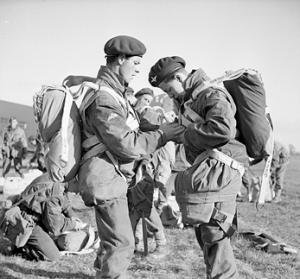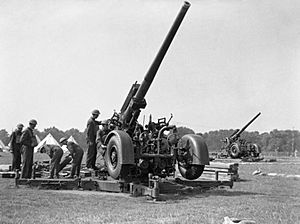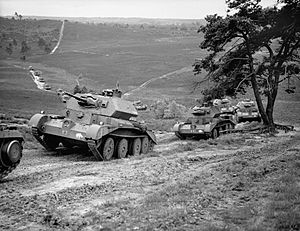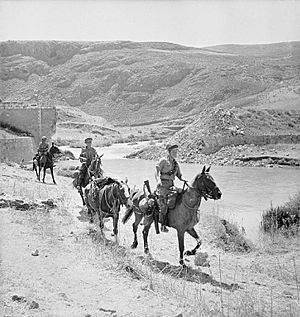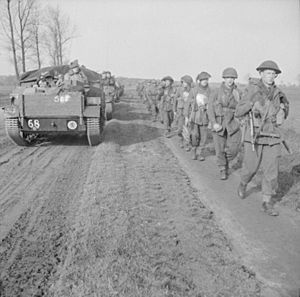List of British divisions in World War II facts for kids
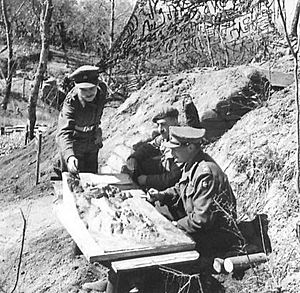
During the Second World War, a "division" was a main military group used by most countries. It was like a self-contained army unit, having everything it needed for fighting. This included its own artillery (big guns), engineers (who built things), communication teams, and supply units.
When the war started on September 3, 1939, the United Kingdom had 2 armoured (tank-based), 24 infantry (foot soldier), and 7 anti-aircraft divisions. The anti-aircraft divisions had a different job; they weren't meant for direct combat like infantry divisions. In September 1939, the British Army planned to create 55 divisions (a mix of armoured, infantry, and cavalry) to fight against Germany. The UK would form 32 of these, and the rest would come from countries like Canada and India, which were part of the British Empire.
By 1941, this goal changed slightly to 57 divisions, with the UK providing 36. The UK met its target by the end of 1941. Throughout the war, 85 different divisions were formed. However, they didn't all exist at the same time, and not all of them were fighting units. For example, the 12th Division (SDF) was created to protect supply lines behind the fighting troops. Some divisions changed types, like the 42nd (East Lancashire) Infantry Division becoming the 42nd Armoured Division. Others, like the 79th Armoured Division, managed scattered units rather than fighting directly.
The 85 divisions included 2 airborne (paratrooper), 12 anti-aircraft, 11 armoured, 1 cavalry, 10 coastal defence (called County Divisions), and 49 infantry divisions. By the end of the war in 1945, the British Army had 24 divisions.
Contents
How the British Army Organized Divisions
Before World War II, the British Army had two main parts: the regular army and the part-time Territorial Army. The regular army's main job was to police and protect the British Empire. A "division" was the basic fighting unit for most armies. These divisions were self-sufficient, meaning they had all the necessary soldiers and equipment for battle. This included their own artillery, engineers, communication teams, and supply units.
In 1939, the regular army had seven infantry and two armoured divisions. The Territorial Army was meant to be the main way to create more divisions when needed. By the start of World War II in September 1939, the Territorial Army was expanding to 24 divisions.
On September 8, 1939, the British Army announced plans to create 55 divisions to send to France as part of the British Expeditionary Force (BEF) to fight Germany. Thirty-two of these would come from the British Army, and the rest from other parts of the British Empire. The goal was to have 20 divisions ready within the first year and all 55 within two years. However, this plan didn't fully happen because of the Battle of France and the Dunkirk evacuation. After the BEF returned to the UK, some divisions were even disbanded to strengthen others.
The target of 55 divisions was later adjusted to 57 in 1941, with the UK providing 36. By the end of 1941, the British Army had 37 active divisions. As the war continued, it became harder to find enough soldiers. Divisions in the UK were often reduced in size to send men to fighting units overseas. By 1944, the army had to transfer men from the Royal Artillery and the Royal Air Force to become infantry soldiers. More divisions were disbanded to provide the needed reinforcements. By the end of 1944, the army had shrunk to 26 divisions, and by the war's final year, it was down to 24.
Airborne Divisions: Soldiers from the Sky
After seeing how effective German airborne forces were in 1940, British Prime Minister Winston Churchill ordered the creation of a 5,000-man paratrooper force. This force grew, and a 10,000-man glider force was also planned. By 1943, two airborne divisions had been formed.
An airborne division usually had three brigades: two parachute brigades (each with three battalions of paratroopers) and one "airlanding" brigade (three infantry battalions carried by gliders). Paratroopers were volunteers from across the military. As the force grew, existing infantry battalions were converted into parachute battalions. Soldiers in airlanding battalions came from existing infantry units and were trained for glider operations.
An airborne division was designed to have 12,148 men and many automatic weapons. This included thousands of rifles, submachine guns, and machine guns. They also had anti-tank weapons, mortars, anti-tank guns, and light howitzers. Over 6,000 vehicles, mostly jeeps, motorcycles, and bicycles, were also part of each division. Heavier equipment was delivered by gliders.
| Formation name | Date formed | Date formation ceased to exist | Divisional insignia | Locations served | Notable campaigns | Notes | Source(s) |
|---|---|---|---|---|---|---|---|
| 1st Airborne Division | 1 November 1941 | 1945 |  |
UK, Tunisia, Italy, Netherlands, Norway | Tunisian, Italian, Operation Market Garden | This division reached its full size in April 1943. After losing many soldiers in the battle of Arnhem, it was reduced from three to two brigades. After Germany surrendered, it was sent to Norway to keep order. It returned to England in August 1945, before the war ended. | |
| 6th Airborne Division | 3 May 1943 | N/A |  |
UK, France, Germany | Normandy, Operation Varsity, Western Allied invasion of Germany | This division was in Germany when the war ended. |
Anti-Aircraft Divisions: Protecting the Skies
From 1935 until the war began, the British Army created anti-aircraft divisions. These were part of the Territorial Army and had a different role than fighting divisions like infantry. Anti-aircraft divisions were assigned to protect specific areas, which could be very large. Their size and the number of weapons they had varied greatly. For example, the 1st Anti-Aircraft Division defended London, while the 3rd Anti-Aircraft Division protected both Scotland and Northern Ireland.
In September 1939, the seven anti-aircraft divisions had fewer guns than planned. They had 695 heavy anti-aircraft guns (out of a planned 2,232) and 253 light anti-aircraft guns (out of 1,200). They also had 2,700 searchlights, compared to a recommended 4,700. By 1941, their equipment numbers had increased significantly. The number of soldiers in these divisions also grew from about 106,000 in 1939 to over 300,000 by mid-1941. All these divisions were disbanded in October 1942 as part of a reorganization to make the anti-aircraft command structure more flexible and save manpower.
| Formation name | Existing formation or date created | Date formation ceased to exist | Divisional insignia | Locations served | Notable campaigns | Source(s) |
|---|---|---|---|---|---|---|
| 1st Anti-Aircraft Division | Existing | October 1942 |  |
UK | Battle of Britain, The Blitz | |
| 2nd Anti-Aircraft Division | Existing | October 1942 |  |
UK | Battle of Britain, The Blitz | |
| 3rd Anti-Aircraft Division | Existing | October 1942 |  |
UK | Battle of Britain, The Blitz | |
| 4th Anti-Aircraft Division | Existing | October 1942 | UK | Battle of Britain, The Blitz | ||
| 5th Anti-Aircraft Division | Existing | October 1942 |  |
UK | Battle of Britain, The Blitz | |
| 6th Anti-Aircraft Division | Existing | October 1942 |  |
UK | Battle of Britain, The Blitz | |
| 7th Anti-Aircraft Division | Existing | October 1942 |  |
UK | Battle of Britain, The Blitz | |
| 8th Anti-Aircraft Division | October 1940 | October 1942 |  |
UK | The Blitz | |
| 9th Anti-Aircraft Division | October 1940 | October 1942 |  |
UK | The Blitz | |
| 10th Anti-Aircraft Division | November 1940 | October 1942 |  |
UK | The Blitz | |
| 11th Anti-Aircraft Division | November 1940 | October 1942 |  |
UK | The Blitz | |
| 12th Anti-Aircraft Division | November 1940 | October 1942 | UK | The Blitz |
Armoured Divisions: Tanks Leading the Charge
Between 1939 and the end of World War II, the way armoured divisions were organized changed nine times. In 1939, an armoured division was supposed to have many light and cruiser tanks, plus tanks with howitzers for close support. It also had about 9,442 men and 2,500 other vehicles. Early armoured divisions didn't always have this many tanks. For example, the 1st Armoured Division went to France in 1940 with fewer tanks than planned.
By 1942, a division was meant to have 13,235 men with 230 tanks (mostly cruisers), about 3,000 other vehicles, and 48 field guns. For the last two years of the war, the plan was for 14,964 men, 246 medium tanks, 63 light tanks, and various specialized tanks and guns. In July 1944, divisions like the Guards, 7th, and 11th Armoured Divisions each had around 250 medium tanks and between 14,400 and 15,600 men.
Early armoured divisions had two armoured brigades (with six tank regiments) and a support group of infantry, engineers, and artillery. Their job was to break through gaps in enemy lines created by infantry divisions. These divisions were considered "tank-heavy" because they didn't have enough infantry to protect the tanks. After problems in the Western Desert campaign, a big reorganization happened. By 1942, a division had one armoured brigade (with three armoured regiments and one motorized infantry battalion) and an infantry brigade with three battalions.
However, the military plan still often had artillery, infantry, and tanks fighting separately. Artillery would attack enemy anti-tank guns, infantry would secure captured areas, and tanks would destroy enemy tanks. Over time, armoured divisions were used more to smash through enemy lines. Armoured divisions in Northwest Europe and Italy were organized slightly differently. In Italy, they added a second infantry brigade to work more closely with the tanks. In Northwest Europe, it took more challenges before military planners realized tanks and infantry needed to work together more closely.
| Formation name | Existing formation or date created | Date formation ceased to exist | Divisional insignia | Locations served | Notable campaigns | Notes | Source(s) |
|---|---|---|---|---|---|---|---|
| Guards Armoured Division | 17 June 1941 | 12 June 1945 |  |
UK, France, Belgium, Netherlands, Germany | Normandy, Allied advance from Paris to the Rhine, Operation Market Garden, Western Allied invasion of Germany | This division was reorganized into the Guards Division on June 12, 1945. | |
| 1st Armoured Division | Existing | 11 January 1945 | UK, France, Egypt, Italian-Libya, Tunisia, Italy | Battle of France, Western Desert, Tunisian, Italian | On April 5, 1943, it was renamed the 1st British Armoured Division to tell it apart from the American one. It stopped being an active fighting unit on October 26, 1944, and was disbanded on January 11, 1945. | ||
| 2nd Armoured Division | 15 December 1939 | 10 May 1941 |  |
UK, Egypt, Italian-Libya | Western Desert | The division's headquarters was captured on April 8, 1941, during an enemy attack. The remaining units were sent to other groups, and the division was officially disbanded on May 10, 1941. | |
| 6th Armoured Division | 12 September 1940 | N/A |  |
UK, Tunisia, Italy, Austria | Tunisian, Italian | This division was in Austria when the war ended. | |
| 7th Armoured Division | Existing | N/A |  |
Egypt, Italian-Libya, Tunisia, Italy, UK, France, Belgium, Netherlands, Germany | Western Desert, Tunisian, Italian, Normandy, Allied advance from Paris to the Rhine, Western Allied invasion of Germany | At the start of the war, this division was renamed from the Mobile Division to the Armoured Division (Egypt); then on February 16, 1940, it became the 7th Armoured Division. It was in Germany when the war ended. The picture shows the division's symbol used in the last two years of the war. | |
| 8th Armoured Division | 4 November 1940 | 1 January 1943 |  |
UK, Egypt | did not see combat as a division | After arriving in Egypt, this division never fought as one complete unit. Its headquarters and some parts took part in the Second Battle of El Alamein. The division was disbanded on January 1, 1943, in Egypt so its soldiers could be sent to other fighting groups. | |
| 9th Armoured Division | 1 December 1940 | 31 July 1944 |  |
UK | did not see combat | This division was disbanded on July 31, 1944. | |
| 10th Armoured Division | 1 August 1941 | 15 June 1944 |  |
Palestine, Egypt, Syria | Western Desert | This division was formed by renaming and reorganizing the 1st Cavalry Division. It was disbanded in Egypt on June 15, 1944. | |
| 11th Armoured Division | 9 March 1941 | N/A |  |
UK, France, Belgium, Netherlands, Germany | Normandy, Allied advance from Paris to the Rhine, Western Allied invasion of Germany | This division was in Germany when the war ended. | |
| 42nd Armoured Division | 1 November 1941 | 17 October 1943 |  |
UK | did not see combat | This division was formed from the reorganization of the 42nd (East Lancashire) Infantry Division. It was disbanded on October 17, 1943. | |
| 79th Armoured Division | 14 August 1942 | N/A |  |
UK, France, Belgium, Netherlands, Germany | Was not intended to act as single entity. The division's units saw combat in Operation Overlord and the Western Allied invasion of Germany. | In April 1943, this division was given the job of developing and using specialized tanks ("Hobart's Funnies"). It went to France as part of Operation Overlord, where its units were given to other groups as needed, while the division still managed them. It was in Germany when the war ended. |
Cavalry Divisions: Horseback Soldiers
Before the war, the British military promised France that the BEF would include at least one cavalry division. This division would be formed by Territorial Army regiments after the war began. It was planned to have 11,097 men, 6,081 horses, and 1,815 vehicles, split into three brigades. Each brigade would have three cavalry regiments.
The division was mainly equipped with rifles, supported by light and medium machine guns, and field guns. For protection against tanks, it was supposed to have 247 anti-tank rifles. Since it was the only division type with horses, it needed three mobile sections from the Royal Army Veterinary Corps to care for the animals. The plan was for the division to be mounted infantry: soldiers would ride horses to move around, then get off their horses to fight.
| Formation name | Date formed | Date formation ceased to exist | Divisional insignia | Locations served | Notable campaigns | Notes | Source(s) |
|---|---|---|---|---|---|---|---|
| 1st Cavalry Division | 31 October 1939 | 1 August 1941 | N/A | UK, France, Palestine, Transjordan, Iraq, Syria | did not see combat as a division | On August 1, 1941, this division was renamed and reorganized as the 10th Armoured Division. |
County Divisions: Defending the Coast
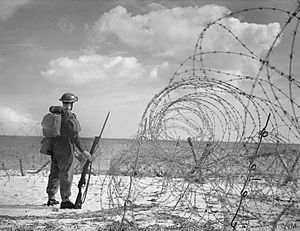
In 1940, after the Battle of France, the UK prepared for a possible German invasion. The army grew quickly, and new infantry battalions were grouped to form county divisions. These divisions had about 10,000 men. Their job was to defend the country's coastlines and operate coastal artillery.
These divisions were mostly fixed in place and didn't have their own artillery, engineers, or reconnaissance units. This allowed regular infantry divisions to be free from coastal duties. Those infantry divisions could then form a reserve further inland, ready to counterattack any enemy forces that landed.
County divisions kept their coastal defense role even after Germany invaded the Soviet Union in June 1941. British military planners worried that if the Soviet Union fell, Germany could easily move many troops to the west. This threat lessened in late 1941. Also, new equipment for the British Army allowed the War Office to better balance the army by creating more armoured and special forces units. Because of this, the county divisions were disbanded or renamed.
Infantry Divisions: The Army's Backbone
Infantry (foot soldiers) were the main part of the British Army. They were meant to be able to move quickly and have enough artillery to defeat enemy forces. At the start of the war, infantry units were either "infantry divisions" or "motor divisions." Each infantry division had three infantry brigades and three artillery regiments. In 1939, these divisions had about 13,863 men and many vehicles and guns. Motor divisions were smaller, with two motorized infantry brigades and two artillery regiments.
The idea was for infantry divisions to break through enemy lines, supported by tanks. Then, armoured divisions would use these gaps, and faster motor divisions would secure the captured areas. However, motor divisions were weaker than infantry divisions because they had fewer men and less firepower. After the Battle of France, the British Army learned lessons and decided to make all standard divisions have three brigades. They also stopped using the motor division concept.
The Army had two types of divisions: regular army (full-time professionals) and Territorial Army (part-time soldiers). Both had divisions. Before the war, Territorial Army soldiers agreed to serve overseas if the government decided it was necessary. This was different from World War I, where Territorial Force members initially didn't have to leave Britain unless they volunteered. Pre-war Territorial Army divisions were called "first-line." They were ordered to create new "second-line" divisions by recruiting more soldiers and forming new units around small groups of experienced soldiers.
In 1941, divisions were split into "higher establishment" (for overseas combat) and "lower establishment" (for home defense, smaller in size). In 1941, a division was planned to have 17,298 men, mostly with rifles, plus many sub-machine guns, light and medium machine guns, mortars, field guns, and anti-tank and anti-aircraft guns, along with over 4,000 vehicles. By 1944, the number of men increased to 18,347, with even more sub-machine guns and anti-tank weapons. About 7,000 of these men were frontline infantry, with the rest in support roles. The actual strength of a division could vary a lot.
In 1942, the British Army tried out "mixed divisions" by replacing one infantry brigade with a tank brigade. This idea wasn't successful and was stopped the next year. By 1943, the War Office wanted to provide eight tank brigades (with infantry tanks) to support the army. These would be attached to infantry divisions as needed. However, due to a lack of tank production, only three such brigades were available. Independent armoured brigades (with M4 Sherman medium tanks) were formed instead and used in a similar way. In Northwest Europe, infantry divisions could also get specialized tanks from the 79th Armoured Division when they needed them.
| Formation name | Existing or date created | Date formation ceased to exist | Divisional insignia | Locations served | Notable campaigns | Branch | Notes | Source(s) |
|---|---|---|---|---|---|---|---|---|
| Guards Division | 12 June 1945 | N/A |  |
North West Europe | did not see combat | Regular Army | This division was formed in Germany after the Guards Armoured Division was reorganized. | |
| 1st Infantry Division | Existing | N/A |  |
UK, France, Belgium, Tunisia, Italy, Palestine | Battle of France, Tunisian, Italian | Regular Army | This division was in Palestine when the war ended. The picture shows its first symbol. | |
| 1st (African) Division | 24 July 1940 20 August 1941 |
24 November 1940 23 November 1941 |
 |
British Kenya, Italian Somaliland, Abyssinia | did not see combat | Regular Army | This division was made up of men from Nigeria and British East Africa. It was renamed the 11th (African) Division on November 24, 1940. It was reformed in Kenya on August 20, 1941, and disbanded again on November 23, 1941. | |
| 1st London Division | Existing | N/A |  |
UK, Iraq, Palestine, Tunisia, Italy, Egypt, Italian-Libya | Tunisian, Italian | First-line Territorial Army | At the start of the war, this was a motor division. It became an infantry division in July 1940 and was renamed the 56th (London) Infantry Division on November 16, 1940. It was in Italy when the war ended. | |
| 2nd Infantry Division | Existing | N/A |  |
UK, France, Belgium, British India, Burma | Battle of France, Battle of Kohima, Burma campaign 1944–45 | Regular Army | This division was in India when the war ended. | |
| 2nd (African) Division | 19 July 1940 | 24 November 1940 |  |
East Africa, Italian Somaliland, Abyssinia | did not see combat | Regular Army | This division was made up of men from the Gold Coast and British East African colonies. It was renamed the 12th (African) Division on November 24, 1940. | |
| 2nd London Division | Existing | N/A |  |
UK | did not see combat | Second-line Territorial Army | This division was a copy of the 1st London Division. At the start of the war, it was a motor division. It became an infantry division in June 1940 and was renamed the 47th (London) Infantry Division on November 21, 1940. In December 1941, it became a smaller "lower establishment" division. It was disbanded on August 31, 1944, and reformed on September 1 as the 47th Infantry (Reserve) Division, a training unit. | |
| 3rd Infantry Division | Existing | N/A |  |
UK, France, Belgium, Netherlands, Germany | Battle of France, Normandy, Allied advance from Paris to the Rhine, Western Allied invasion of Germany | Regular Army | This division was in Germany when the war ended. | |
| 4th Infantry Division | Existing | N/A |  |
UK, France, Belgium, Tunisia, Egypt, Italy, Greece | Battle of France, Tunisian, Italian, Greek Civil War | Regular Army | The picture shows this division's first symbol. It was in Greece when the war ended. | |
| 5th Infantry Division | Existing | N/A |  |
UK, France, Belgium, British India, Iraq, Iran, Syria, Egypt, Italy, Palestine, Germany | Battle of France, Allied invasion of Sicily, Italian, Western Allied invasion of Germany | Regular Army | This division was in Germany when the war ended. | |
| 6th Infantry Division | 3 November 1939 17 February 1941 |
17 June 1940 10 October 1941 |
 |
Egypt, Palestine, Greece, Syria, Italian-Libya | Battle of Crete, Syria-Lebanon, Siege of Tobruk | Regular Army | This division was formed by renaming the 7th Infantry Division. It stopped existing on June 17, 1940, and was reformed on February 17, 1941. It was then renamed the 70th Infantry Division on October 10, 1941. | |
| 7th Infantry Division | Existing | 3 November 1939 | N/A | Palestine, Egypt | did not see combat | Regular Army | This division was renamed the 6th Infantry Division on November 3, 1939. | |
| 8th Infantry Division | Existing 2 June 1942 |
3 November 1939 31 October 1943 |
 |
Palestine, Syria | did not see combat | Regular Army | The original division was disbanded on February 28, 1940. A new 8th Division, called '8th Division (Syria)', was created on June 2, 1942. It was for keeping order and mostly had administrative staff. The reformed division was disbanded on October 31, 1943. | |
| 9th (Highland) Infantry Division | Existing | 7 August 1940 |  |
UK | did not see combat | Second-line Territorial Army | This division was a copy of the 51st (Highland) Infantry Division. On August 7, 1940, it was renamed the 51st (Highland) Infantry Division. | |
| 11th (African) Division | 24 November 1940 | 26 July 1941 |  |
British Kenya, Italian Somaliland, Abyssinia | East African | Regular Army | This division was formed when the 1st (African) Division was renamed. | |
| 11th (East Africa) Division | 15 February 1943 | N/A |  |
East Africa, Ceylon, Burma, British India | Burma | Regular Army | This division was made up of men from Kenya, Northern Rhodesia, Nyasaland, Tanganyika, and Uganda. The picture shows its first symbol. It was in India when the war ended. | |
| 12th (African) Division | 24 November 1940 | 18 April 1943 |  |
East Africa, Italian Somaliland, Abyssinia | East African | Regular Army | This division was formed when the 2nd (African) Division was renamed, and was disbanded on April 18, 1943. | |
| 12th (Eastern) Infantry Division | 10 October 1939 | 11 July 1940 |  |
UK, France | Battle of France | Second-line Territorial Army | This division was a copy of the 44th (Home Counties) Infantry Division. It was disbanded on July 11, 1940, after returning to the UK. | |
| 12th Division (SDF) | 11 July 1942 | 12 January 1945 |  |
Italian-Libya | did not see combat | Regular Army | This division was formed by renaming the 1st Sudan Defence Force Brigade. It served as a security force protecting supply lines behind the Eighth Army. On January 12, 1945, it lost its division title and was renamed the Sudan Defence Force Group (North Africa). A white diamond was used as its symbol, possibly with the Sudan Defence Force symbol. | |
| 15th (Scottish) Infantry Division | Existing | N/A |  |
UK, France, Belgium, Netherlands, Germany | Normandy, Allied advance from Paris to the Rhine, Western Allied invasion of Germany | Second-line Territorial Army | This division was a copy of the 52nd (Lowland) Infantry Division. It was in Germany when the war ended. | |
| 18th Infantry Division | 30 September 1939 | 15 February 1942 |  |
UK, British India, Malaya, Singapore | Battle of Singapore | Second-line Territorial Army | This division was a copy of the 54th (East Anglian) Infantry Division. On February 15, 1942, after the Battle of Singapore, its soldiers were taken prisoner. | |
| 23rd (Northumbrian) Division | 2 October 1939 | 30 June 1940 |  |
UK, France | Battle of France | Second-line Territorial Army | This division was a copy of the 50th (Northumbrian) Infantry Division. It was disbanded on June 30, 1940, after returning to the United Kingdom. | |
| 36th Infantry Division | 1 September 1944 | N/A |  |
Burma, British India | Burma | Regular Army | This division was formed by renaming the 36th Indian Infantry Division. It was in India when the war ended. | |
| 38th (Welsh) Infantry Division | 18 September 1939 1 September 1944 |
15 August 1944 N/A |
 |
UK | did not see combat | Second-line Territorial Army | This division was a copy of the 53rd (Welsh) Infantry Division. It became a smaller "lower establishment" division on December 1, 1941, and was disbanded on August 15, 1944. It was reformed as the 38th Infantry (Reserve) Division, a training unit, on September 1, 1944. | |
| 42nd (East Lancashire) Infantry Division | Existing | 1 November 1941 |  |
UK, France, Belgium | Battle of France | First-line Territorial Army | On November 1, 1941, this division was renamed and reorganized as the 42nd Armoured Division. | |
| 43rd (Wessex) Infantry Division | Existing | N/A |  |
UK, France, Belgium, Netherlands, Germany | Normandy, Allied advance from Paris to the Rhine, Operation Market Garden, Western Allied invasion of Germany | First-line Territorial Army | This division was in Germany when the war ended. | |
| 44th (Home Counties) Infantry Division | Existing | 31 January 1943 |  |
UK, France, Egypt | Battle of France, Second Battle of El Alamein | First-line Territorial Army | This division was disbanded in Egypt so its soldiers could be sent to other groups to keep them strong. | |
| 45th Infantry Division | Existing | N/A |  |
UK | did not see combat | Second-line Territorial Army | This division was a copy of the 43rd (Wessex) Infantry Division. It became a smaller "lower establishment" division in December 1941, and was disbanded on August 30, 1944. It was reformed as the 45th (Holding) Division on September 1, to replace the 77th (Holding) Division, and was renamed the 45th Division on December 1, 1944. | |
| 46th Infantry Division | 2 October 1939 | N/A |  |
UK, France, Tunisia, Italy, Egypt, Palestine, Greece, Austria | Battle of France, Tunisian, Italian, Greek Civil War | Second-line Territorial Army | This division was a copy of the 49th (West Riding) Infantry Division. It was in Austria when the war ended. | |
| 48th (South Midland) Infantry Division | Existing | N/A |  |
UK, France, Belgium | Battle of France | First-line Territorial Army | This division became a smaller "lower establishment" division in November 1941. On December 20, 1942, it was renamed the 48th Infantry (Reserve) Division, a training unit. | |
| 49th (West Riding) Infantry Division | Existing | N/A |  |
UK, Iceland, France, Belgium, Netherlands | Normandy, Allied advance from Paris to the Rhine, Western Allied invasion of Germany | First-line Territorial Army | This division became "Alabaster Force" for the occupation of Iceland. When it returned to the UK in 1942, it was reformed as the 49th (West Riding) Infantry Division. It was in the Netherlands when the war ended, under Canadian command. | |
| 50th (Northumbrian) Infantry Division | Existing | N/A |  |
UK, France, Belgium, Egypt, Cyprus, Iraq, Syria, Italian-Libya, Tunisia, Italy, Norway | Battle of France, Western Desert, Tunisian, Allied invasion of Sicily, Normandy, Western Allied invasion of Germany | First-line Territorial Army | This division started the war as a motor division and was reorganized as an infantry division in June 1940. On December 16, 1944, after being pulled out of Europe, it was renamed the 50th Infantry (Reserve) Division, a training unit. On August 1, 1945, the division's headquarters moved to Norway and became British Land Forces Norway. | |
| 51st (Highland) Infantry Division | Existing 7 August 1940 |
N/A |  |
UK, France, Belgium, Egypt, Italian-Libya, Tunisia, Italy, Netherlands, Germany | Battle of France, Western Desert, Tunisian, Allied invasion of Sicily, Italian, Normandy, Allied advance from Paris to the Rhine, Western Allied invasion of Germany | First-line Territorial Army | This division was captured in France in 1940. It was then reformed on August 7, 1940, by renaming the 9th (Highland) Infantry Division in the United Kingdom. It was in Germany when the war ended. | |
| 52nd (Lowland) Infantry Division | Existing | N/A |  |
UK, France, Belgium, Netherlands, Germany | Allied advance from Paris to the Rhine, Western Allied invasion of Germany | First-line Territorial Army | This division was sent to France for seven days in June 1940, after the Dunkirk Evacuation. When it returned to the UK, it trained as a mountain division and then for airlanding operations. It didn't fight in either role, and was sent out in October 1944 as an infantry division. It was in Germany when the war ended. | |
| 53rd (Welsh) Infantry Division | Existing | N/A |  |
UK, France, Belgium, Netherlands, Germany | Normandy, Allied advance from Paris to the Rhine, Western Allied invasion of Germany | First-line Territorial Army | This division was in Germany when the war ended. | |
| 54th (East Anglian) Infantry Division | Existing | 14 December 1943 |  |
UK | did not see combat | First-line Territorial Army | This division became a smaller "lower establishment" division in January 1942, and was disbanded on December 14, 1943. | |
| 55th (West Lancashire) Infantry Division | Existing | N/A |  |
UK | did not see combat | First-line Territorial Army | This division was a motor division at the start of the war and was reorganized as an infantry unit in June 1940. It became a smaller "lower establishment" division in January 1942, and was raised to a larger "higher establishment" in May 1944. It was later drained of soldiers until it no longer existed, but its name was kept for deception purposes. | |
| 59th (Staffordshire) Infantry Division | 15 September 1939 | 19 October 1944 |  |
UK, France | Normandy | Second-line Territorial Army | This division was a copy of the 55th (West Lancashire) Infantry Division. It started the war as a motor division and was reorganized as an infantry division in June 1940. At the end of the Normandy Campaign, the division was broken up to provide soldiers for other units. Its headquarters was put into 'suspended animation' on October 19, 1944, and was never reformed. | |
| 61st Infantry Division | Existing | N/A |  |
UK | did not see combat | Second-line Territorial Army | This division was a copy of the 48th (South Midland) Infantry Division. Its headquarters went to Norway during the Norwegian Campaign, but the division itself didn't deploy. In August 1945, it was reorganized as a Light Division. | |
| 66th Infantry Division | 27 September 1939 | 23 June 1940 |  |
UK | did not see combat | Second-line Territorial Army | This division was a copy of the 42nd (East Lancashire) Infantry Division, and was disbanded on June 23, 1940. | |
| 70th Infantry Division | 10 October 1941 | 24 November 1943 |  |
Italian-Libya, Egypt, British India | Siege of Tobruk | Regular Army | This division was formed by renaming the 6th Infantry Division. In September 1943, it was assigned to the Chindits and began reorganizing into long-range penetration units. The division stopped working on October 24 and was disbanded on November 24, 1943. | |
| 76th Infantry Division | 18 November 1941 | 1 September 1944 |  |
UK | did not see combat | Regular Army | This division was formed as a smaller "lower establishment" unit by renaming the Norfolk County Division. It was renamed the 76th Infantry (Reserve) Division, a training unit, on December 20, 1942. On September 1, 1944, the division was disbanded. | |
| 77th Infantry Division | 1 December 1941 | 1 September 1944 |  |
UK | did not see combat | Regular Army | This division was formed as a smaller "lower establishment" unit by renaming the Devon and Cornwall County Division. It was renamed the 77th Infantry (Reserve) Division, a training unit, on December 20, 1942. On December 1, 1943, it was renamed the 77th Holding Division, which temporarily held, retrained, and sorted soldiers. The division was disbanded on September 1, 1944. | |
| 78th Infantry Division | 25 May 1942 | N/A |  |
UK, Tunisia, Italy, Austria | Tunisian, Allied invasion of Sicily, Italian | Regular Army | This division was in Austria when the war ended. | |
| 80th Infantry (Reserve) Division | 1 January 1943 | 1 September 1944 |  |
UK | did not see combat | Regular Army | This division was formed as a training unit, and was disbanded on September 1, 1944. | |
| 81st (West Africa) Division | 1 March 1943 | N/A |  |
Nigeria, British India, Burma | Burma | Regular Army | This division was made up of men from Nigeria, the Gold Coast, and Sierra Leone. Its first name, which lasted for three days, was the 1st (West African) Division. It was in India when the war ended. | |
| 82nd (West Africa) Division | 1 August 1943 | N/A |  |
Nigeria, British India, Burma | Burma | Regular Army | This division was made up of men from Nigeria, the Gold Coast, and Sierra Leone. It was in Burma when the war ended. | |
| Beauman Division | 29 May 1940 | June 1940 | N/A | France | Battle of France | Regular Army | This was a temporary division formed from available soldiers to defend Rouen and Dieppe. It didn't have the usual support units. The division was disbanded after its evacuation from France on June 17, 1940. | |
| Royal Marines Division | August 1940 | April 1943 |  |
UK | did not see combat as a division | Royal Marines | This division was disbanded in April 1943. Its men were either trained to operate landing craft or joined the Commandos and helped create six new Royal Marine units. | |
| Y Division | February 1943 | 16 March 1943 | N/A | Tunisia | Tunisian | Regular Army | This was a temporary group formed during the Tunisia Campaign, and was disbanded on March 16, 1943. |
See also
- British deception formations in World War II
- Divisional insignia of the British Army
- List of British divisions in World War I
- List of British brigades of the Second World War
- Military history of Britain during World War II


